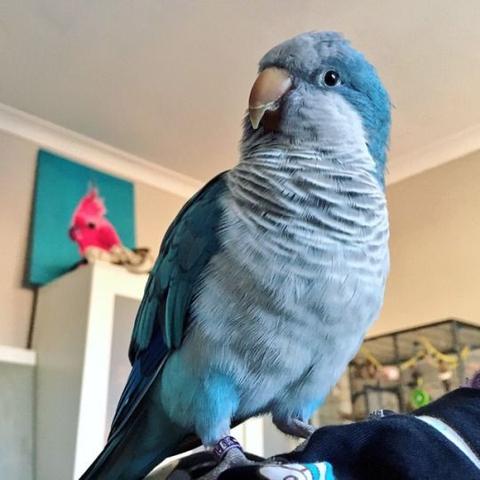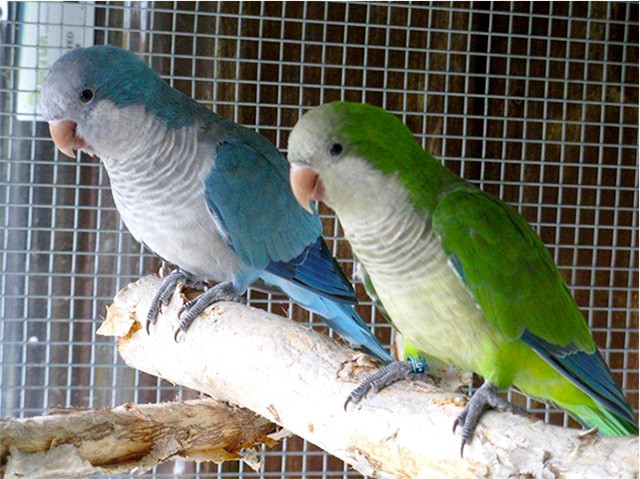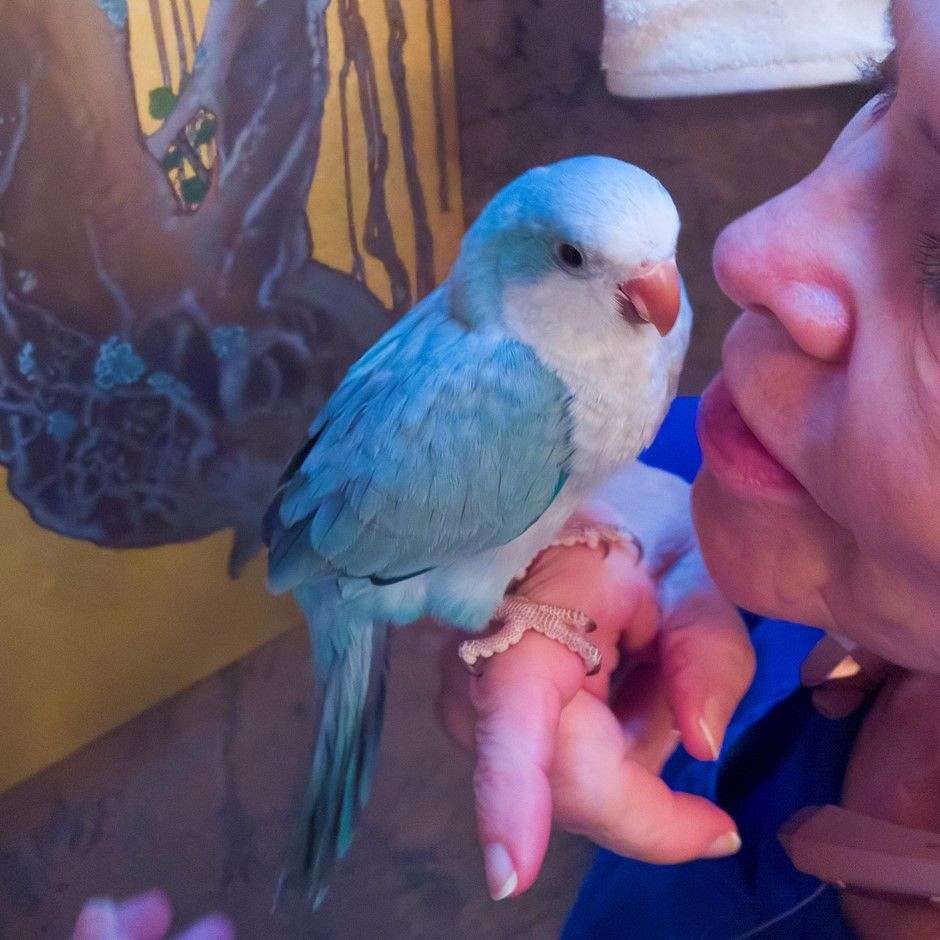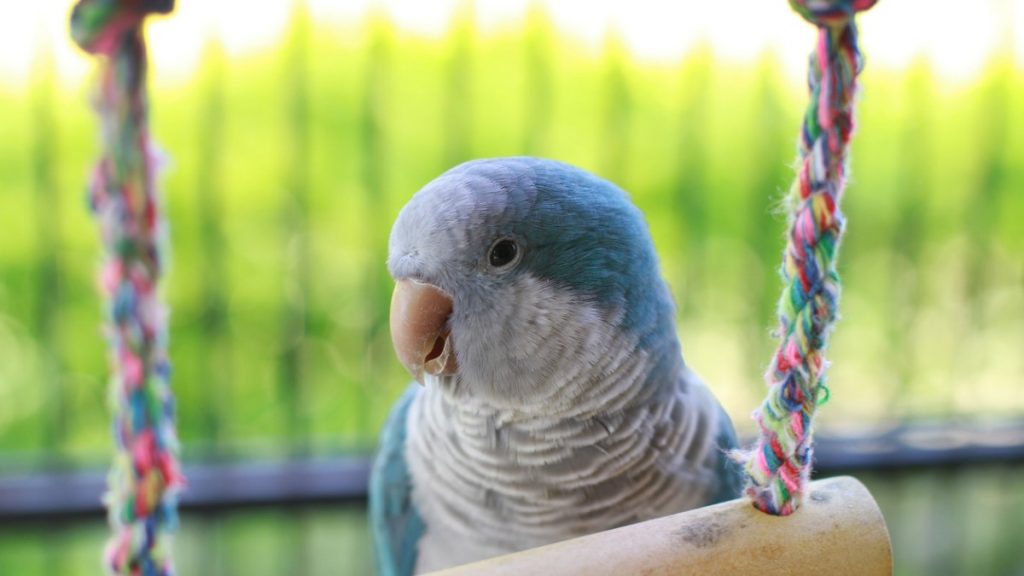
Many people tend to seek company in small animals that can brighten their day and turn their space into a more cheerful and full of good energy. Blue Quakers Parrots are perfect for bird lovers who want to have a playful, talkative, and precious pet.
The scientific name of these small birds is Myiopsitta monachus, and they belong to the Psittacidae family. They are quite common to find in Latin American countries like Argentina, Bolivia, and Brazil; however, there are large populations of blue quaker parrot in the wild in Europe and the United States.
This lovely and friendly parrot attracts a lot of attention from the first moment thanks to its beautiful plumage of a rather peculiar blue color. In many, blue tends to be darker than others, so much so that they can actually be perceived as a bluish-gray. Still, there are more fascinating features to help ensure that including a blue quaker parrot in your home is an excellent one decision:

Blue quaker parrot characteristics
These magnificent pets are not only precious creatures but all the characteristics that make them up to make these birds the best companions to include in your home:
Its size is perfect
It doesn’t matter if you have a very small home; you can always have your quaker parrot without problems thanks to their size of up to only eleven inches from tail to beak.
When they reach adulthood, their weight can reach a maximum of 100 grams, but this is quite unusual.
Its appearance is worthy of admiration
In short, the blue quaker bird is one of the most tender and beautiful birds of the entire family of monk parakeets. Their blue plumage is completely mind-blowing and unique, so it’s a simple task to distinguish them from the other usually green quaker parrot:
- Both the wings and the back have a lighter blue color, and all that tone extends to its long tail.
- In the area of the chest and the lower part of the wings, you can perceive a more grayish color with a tendency to blue, this same color of plumage appears on the forehead.
- It has a more colorful bill, is bright orange in color, and stands out in a very powerful way.
- Her eyes are dark and are surrounded by two white, ring-shaped circles.
It is difficult to know the sex of the bird without DNA tests, but a tip that can be useful when choosing a quaker parrot is to verify each one’s size. Males are generally slightly larger than females.
They are talkative by nature
The parrots that are offered, in general, are already lightly trained; this means that they know certain words; however, blue quaker parrot is very talkative and quite clever, so it is more than certain that when they arrive at their new home, they will quickly learn new words.
They have an impressively large vocabulary, they are able to say simple phrases, but they can be understood very well, and that agrees with the context in which it is and with its feelings or requirements.
The blue quaker generally makes quite loud sounds, even while eating. This can be quite positive because it helps to warn if another animal has approached its cage.
They are funny and social
Blue quaker parrot has a very funny and funny personality. They are birds that are not shy and can be easily related to people who are not necessarily their owners.
It is this attractive personality that makes blue quaker parrot ideal to be part of your family.

What do you need to have before you get a blue quaker?
When this bird is free in the wild, they tend to adapt to various climatic environments and live in nests. However, when one of these birds is acquired to have them in the home, the owner must ensure that her home is the most suitable so that the living condition of her pet is the healthiest and longest possible.
Good quality and spacious cage
The blue quakers tend to be birds that enjoy flying for hours, have a lot of energy, and love being able to move freely. This is why before you buy one of these birds as a pet, buy a super spacious cage so that they feel free to fly around as much space as they can.
It would be best if you preferably chose a cage that does not affect the bird’s health. Metal, for example, does not contain harmful substances like plastic, which will help keep your Blue Quaker healthy. Avoid acquiring wooden cages, as these birds tend to bite a lot, and their beaks are so sharp that there will come the point where the cell will just be a bunch of splinters.
Uv lamp
If you live in an area where winter reaches shallow degrees, it is recommended that you have an ultraviolet lamp so that you can compensate for the lack of sunlight this season. The Blue Quaker are birds that need a lot of sunlight when winter comes, and if this is not prevented, it could cause health problems for your pet.
Assorted foods
The blue quaker is prone to liver diseases if they aren’d fed correctly; therefore, you must have a variety of foods at home so that they are nourished with minerals and vitamins:
- You can make mixtures of cereals, also herbs, and a few leaves
- Fruits and vegetables are essential in its diet
- For their rewards, you can give them natural fruit juices and fresh cookies
- You can include some insects, seeds, and nuts, but do not base its diet on only these foods; in this way, you prevent obesity.
Fun toys
There is an infinite number of toys that you can buy for your quaker parrot. These help to stimulate the objects that these birds usually look for when they are in their natural habitat; in this way, they will stay entertained; In addition, they are very useful to train them and keep them in shape.
It is preferable to choose toys that have simple designs and that are made of natural materials because these birds bite the toys, and you should avoid as much as possible that they ingest toxic particles.
Try that all the toys are varied and that they are an appropriate size, not too big or too small. Quaker Parrots can easily get bored with toys that are not easy to use or that look strange.

How should you care for a blue quaker parrot?
These birds, despite having a fairly long life expectancy, tend to suffer from various diseases that can be easily avoided and treated with proper care:
Take care of their hygiene
Ensure its space is always clean, so your parakeet is always comfortable and prevents it from acquiring infections. If it eats organic foods like fruits and vegetables, it is advisable to clean up what they leave behind before it spoils.
In addition, you should ensure that it takes a bath at least every two days. For this, you can use a somewhat deep basin that contains warm or ambient water, but if you are not yet used to doing it yourself, you can also take a spray bottle with water to spray it and keep it fresh and clean.
The depth of the container that you use to bathe must be small. The way to calculate it is that when the bird stands, the water only reaches its legs; In addition, you must remove it once it has bathed until the next day.
Prepare your blue quaker for life as a couple
It is always recommended that parakeets are not completely solitary. If you want to have a whole family of blue quaker parrot, you should avoid bringing the birds together immediately if they have not lived together before.
Both parakeets will need to be in separate cages while they get to know each other and adjust to their presence, as they can be very territorial with their space. When you make sure that a prudent time has passed and that they are used to being together, you can place them in a single cage.
If they are male and female and want them to reproduce, try to place nest boxes on them to avoid that the structure is not destroyed when the chicks hatch. If this happens, the parents will abandon their chicks early.
You must bear in mind that females can lay up to eleven eggs, so before they are born, they must have everything they need to have a spacious home.
Try to keep them exercised
It is essential that blue quakers are in constant motion; in this way, you avoid liver diseases, which are very common in them, and you also make sure they are always healthy and happy.
To make sure they always exercise, use toys that stimulate them, such as:
- Physical stimulants: These are several tubes joined together that could simulate the branches of a tree. With this toy, the blue quaker parrots will be able to exercise and use their legs as they would in their natural habitat.
- Food Finder: They are fantastic toys to entertain for a long time. Just as they would in their natural habitat, the parakeets will try to find the food that is inside the toy until they get it.
- Toys to break: Blue quaker parrot love to bite with their sharp beak everything they see; that is why break-away toys are indicated for this type of bird. You will see them concentrated for hours.
- Ropes: Climbing is an activity that they enjoy a lot. By buying a rope that you can tie from the top of the cage, you will have given your parakeet a toy that he will love forever.
Surprise them with new foods
These birds tend to get bored very quickly with things, including food. Avoid that its diet is based on only seeds because it can have serious consequences on its health; and, in turn, avoid constantly repeating the same diet.
They love to feast on new flavors and textures. Water, for example, can be flavored with a little lemon or honey. They love cookies, creamy fruit, and bugs.
It is recommended that, if you are in the training process, its reward is a portion of delicious food that it have not consumed constantly; in this way, it will stay attentive and happy.
Constantly interact with your parakeet
The blue quakers are a brilliant and sociable animal, so it is an excellent idea to share with this pet for at least an hour a day. You can spend that time talking to him, singing to him, or even just whistling next to him.
These interactions will not only make him become closer to you, but he may also learn new words in the process. With these frequent interactions, you can get your bird to see you as part of his family.
Stimulates their sense of sight and sound
Sometimes everyday life can be very busy, so you may not have enough time to spend with your bird on some occasions. When this happens, an excellent alternative will be to leave it with audio reproductions with your voice, either: talking to it, singing to it, or repeating words to it.
Using videos or even the radio can work; the idea is that your pet does not feel alone during the day and can have sound stimuli around her.
Why is the blue quaker parrot perfect for anyone?
Pets are considered that ray of light that is often lacking in a home. In the blue quaker parrot case, it is more than certain that they will be that fun and wonderful spark that can fill your space with very positive vibes. So if you want a pet that does not require your constant attention or takes up a lot of space in your home but is friendly and fun, without a doubt, the blue quaker parrot will be perfect for you.